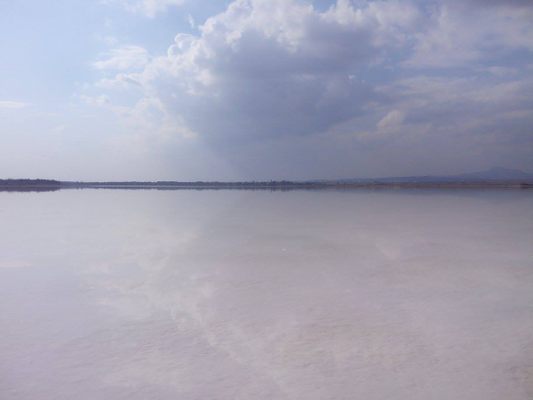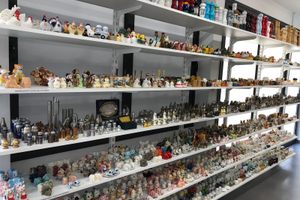About
The Larnaca Salt Lake has the same ephemeral beauty of a mirage or oasis. Known as Αλυκή Λάρνακας in Greek and Larnaka Tuz Gölü in Turkish, this shimmering, otherworldly lake is actually a complex of wetlands: Alyki, Orphani, Soros, and Spiro, in decreasing order of size.
Only the largest, Alyki, is a true salt lake. In total, the wetlands and lake comprise 4,352 acres (1,761 hectares). Though this briny body of water is actually smaller than Limassol Salt Lake—making it the second largest of its kind on Cyprus—it is arguably the most significant.
The small Mediterranean island’s summers don’t see much precipitation. Consequently, the lake becomes so dry that in certain areas, all that is left is an exposed layer of caked salt. Come winter, though, heavy rains inundate the island, and the lake fills again. In these waters, ostracods (seed shrimp), Branchinella spinosa (fairy shrimp), and Artemia salina (a species of brine shrimp) propagate and are an essential source of food for the flamingos that use the island as a rest stop during their annual migration. Wild ducks and gulls also frequent the lakes, availing themselves of the salty snacks found therein.
In addition to its significance as a biotope, Larnaca Salt Lake and its environs are historically important. Before sediment deposit cordoned off the salt lakes, they formed a lagoon that was connected to the Mediterranean Sea. This lagoon was Cyprus’s largest cove and was used as a port during the second millennium BC. Larnaca, which was known as Kition, was among the most important trading posts in the ancient world—hardly surprising, given its strategic location in waters easily accessible from Africa, Asia, and Europe.
There is even evidence that as the two natural channels connecting the lagoon to the sea become increasingly shallow due to aggregating particulate, Bronze Age Cypriots dug a human-made channel so as to keep the port city in operation. Beyond its convenience and accessibility, the harbor was important because of Kitium’s huge salt-exporting business.
While this information has given rise to the impression that Larnaca Salt Lake’s saline nature is a result of sea water, this is actually not the case. Water from seasonal rains fills the area, which eventually dissolves a huge underground reserve of salt. Once the water evaporates, the remaining salt to water ratio is increased, resulting in a flat plain of dry salt during the driest months.
The lake also features prominently in Christian and Muslim lore. Christians believe that a hungry and thirsty Saint Lazarus asked a wealthy vineyard owner for nourishment, and she lied, saying that her vines were dry. For her coldhearted greed, Lazarus supposedly cursed her land to become a salt lake.
For Muslims, the area is important because Hala Sultan Tekke, also known as the mosque of Umm Haram, sits on the edge of the lake. This mosque serves as a shrine to Ubada bint al-Samit, a companion (some say wet nurse and foster mother, though this is disputed) of Mohammed. She is rumored to have died here by falling off a mule during the caliph Muawiyah I’s invasion of Cyprus in 647. Later, the mosque became a residence for Sufi dervishes, who were known for worshipping God through beautiful dancing and chanting.
Related Tags
Know Before You Go
There are no public bathrooms nearby, so make sure to factor this into your travel plans. It's not a bad idea to bring a bottle of water. Definitely wear sunscreen! There's lot of reflection and no shade.
Published
April 2, 2019
Sources
- https://www.researchgate.net/profile/Benoit_Devillers/publication/269630372_Palaeo-environment_Larnaca_Salt_Lakes_2014/links/54902ff10cf225bf66a82396/Palaeo-environment-Larnaca-Salt-Lakes-2014.pdf
- http://med-ina.org/Portals/0/Uploads/Tunis%20workshop%20presentations/SALT%20LAKE%20TUNIS%20-%20Michaelides.pdf
- http://ramsar.rgis.ch/pdf/mtg/mtg_reg_europe2004_docs1g1.pdf
- http://larnakaregion.com/uploads/files/Larnaka_Salt_Lakes_leaflet_en.pdf
- https://www.academia.edu/18102757/Late_Pleistocene_and_Holocene_uplift_history_of_Cyprus_implications_for_active_tectonics_along_the_southern_margin_of_the_Anatolian_microplate
- https://www.keele.ac.uk/gge/studyatgge/postgraduatecourses/postgraduateprojects/quarternaryenvironmentsandpalaeoclimates/thesedimentaryrecordofthelarnacasaltlakecyprus/
- http://larnakaregion.com/directory/product/larnaka-salt-lake
- http://larnakaregion.com/directory/product/larnaka-salt-lake
- https://www.academia.edu/9731318/Paleo-environmental_evolution_of_the_Larnaca_Salt_Lakes_Cyprus_and_the_relationship_to_second_millennium_BC_settlement
- https://www.academia.edu/18102757/Late_Pleistocene_and_Holocene_uplift_history_of_Cyprus_implications_for_active_tectonics_along_the_southern_margin_of_the_Anatolian_microplate
- https://jgs.lyellcollection.org/content/56/1-4/745
- http://med-ina.org/Portals/0/Uploads/Tunis%20workshop%20presentations/SALT%20LAKE%20TUNIS%20-%20Michaelides.pdf
- http://larnakaregion.com/uploads/files/Larnaka_Salt_Lakes_leaflet_en.pdf




































